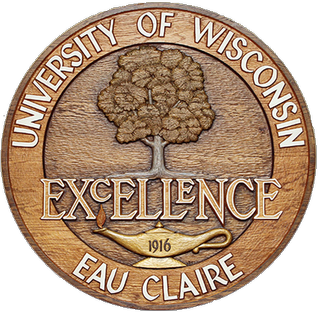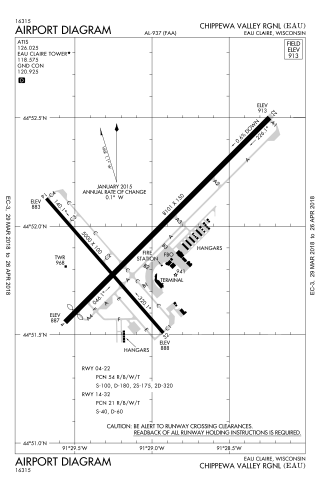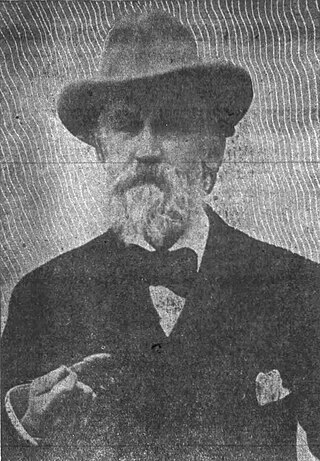
Eau Claire County is a county located in the U.S. state of Wisconsin. As of the 2020 census, the population was 105,710. Its county seat is Eau Claire. The county took its name from the Eau Claire River.

Dunn County is a county in the U.S. state of Wisconsin. As of the 2020 census, the population was 45,440. Its county seat is Menomonie. Dunn County comprises the Menomonie Micropolitan Statistical Area and is included in the Eau Claire-Menomonie, WI Combined Statistical Area.

Chippewa County is a county located in the U.S. state of Wisconsin. It is named for the historic Chippewa people, also known as the Ojibwe, who long controlled this territory. As of the 2020 census, the population was 66,297. Its county seat is Chippewa Falls. The county was founded in 1845 from Crawford County, then in the Wisconsin Territory, and organized in 1853.

Eau Claire is a city in Eau Claire and Chippewa counties in the U.S. state of Wisconsin. It is the county seat of Eau Claire County. It had a population of 69,421 in 2020, making it the state's eighth-most populous city. It is the principal city of the Eau Claire metropolitan area, locally known as the Chippewa Valley, and is also part of the larger Eau Claire–Menomonie combined statistical area.

The University of Wisconsin–Eau Claire is a public university in Eau Claire, Wisconsin. It is part of the University of Wisconsin System and offers bachelor's and master's degrees.
Carson Park is a historic park located in Eau Claire, Wisconsin. It is located on a 134-acre (54.2 ha) peninsula created on an oxbow lake, Half Moon Lake, which was part of the former course of the Chippewa River. The park contains baseball, football, and softball venues, as well as the Chippewa Valley Museum.

Chippewa Valley Regional Airport is a public use airport in Chippewa County, Wisconsin, United States. The airport is owned by Eau Claire county and is located 3 nautical miles north of the central business district of the city of Eau Claire, Wisconsin.

The Chippewa Valley is a valley in Wisconsin, US.

Carson Park is a baseball stadium located in Carson Park, a park in Eau Claire, Wisconsin. It was built as a Works Progress Administration project in 1936, and it is listed on the National Register of Historic Places.
The McCann brothers were three Irishmen who migrated from Ohio to Wisconsin in the mid-nineteenth century. They played an important role in the early phases of Wisconsin's lumber industry, and in the political and social organization of Chippewa County.
Putnam Park is a 230-acre (0.93 km2) state natural area owned by the University of Wisconsin–Eau Claire. The park is located in the middle of the city of Eau Claire and follows the course of both the Chippewa River to the west and Minnie Creek to the east. Much of the park lies on the boundary of the Third Ward neighborhood. The park sits directly south of a steep section of Harding Avenue, once called "Plank Street Hill."

Henry Cleveland Putnam was a philanthropist and lumber baron in the Chippewa Valley of Wisconsin, also serving as a member of the Wisconsin State Forestry Commission. In Eau Claire he is known as H. C. Putnam and is regarded as one of the founders of the city. He donated the land for the eponymous Putnam Park in Eau Claire.
Phoenix Park is a public space in downtown Eau Claire, Wisconsin, located on a former brownfield site at the confluence of the Chippewa River and the Eau Claire River. It covers approximately 9 acres with approximately 1/2 mile of riverbank frontage. The park serves as the trailhead for the Chippewa River State Trail. The park also offers a walking labyrinth, a natural amphitheater, and is home to Eau Claire's year-round farmer's market. These amenities make Phoenix Park a major gathering spot, especially during the summer months when the park plays hosts to concerts. The park is owned and operated by the City of Eau Claire.

The Eau Claire Area School District (ECASD) is a school district in western Wisconsin and the eighth-largest district in the state.

St. Patrick's Church is a historic Catholic church built in 1885 in Eau Claire, Wisconsin. It was added to the National Register of Historic Places in 1983 for its architectural significance.

First Methodist Episcopal Church is a Neogothic Revival-styled church built in 1911 in Eau Claire, Wisconsin. It was added to the National Register of Historic Places in 1999 for its architectural significance.

The James Stephen Hoover and Elizabeth Borland Memorial Chapel is located in Eau Claire, Wisconsin. It was added to the National Register of Historic Places in 2000 for its architectural significance.

St Luke's Anglican Church is a heritage-listed church at 152 Herries Street, Toowoomba City, Queensland, Australia. It is the second church on the site and was designed by John Hingeston Buckeridge and built in 1897. It is also known as St Luke's Church of England. It was added to the Queensland Heritage Register on 28 July 2000.
Adin Randall was a philanthropist, businessman, and politician in the Chippewa Valley of Wisconsin, who served as a first Treasurer of Eau Claire County, Wisconsin. He ran a ferry across the Chippewa, a planing mill, a sash and door factory, and invented the sheer boom to efficiently shunt logs into Half Moon Lake. He is regarded as one of the founders of the city. He donated the land for Randall Park, Lakeview Cemetery and the Eau Claire Area School District.

Orrin Henry Ingram was an American lumber baron and philanthropist from Eau Claire, Wisconsin. Orphaned at age 11, he established sawmills in Ontario, Canada, and the Chippewa Valley of Wisconsin. He was a banker and philanthropist in Eau Claire.















